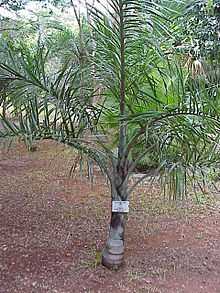Pseudophoenix sargentii
| Pseudophoenix sargentii | |
|---|---|
 | |
| Pseudophoenix sargentii | |
| Scientific classification | |
| Kingdom: | Plantae |
| (unranked): | Angiosperms |
| (unranked): | Monocots |
| (unranked): | Commelinids |
| Order: | Arecales |
| Family: | Arecaceae |
| Genus: | Pseudophoenix |
| Species: | P. ekmanii |
| Binomial name | |
| Pseudophoenix sargentii H.Wendl. ex Sarg. | |
Pseudophoenix sargentii (buccaneer palm, Sargent’s cherry palm, cherry palm, palma de guinea, cacheo, kuká) [1][2] is a medium-sized palm found in the northern Caribbean, south to Dominica and adjacent parts of the mainland (Florida in the United States, Quintana Roo in Mexico[2] and Belize)[3]
Description
Pseudophoenix sargentii is usually near the sea on sandy or limestone soils. The plant has solitary stems, 4–8 metres tall and up to 30 centimetres in diameter, often slightly swollen.[2]
Cultivation
Pseudophoenix sargentii is cultivated in the specialty horticulture trade and available as an ornamental palm for private gardens, habitat gardens, and various types of municipal, commercial, and agency sustainable landscape and restoration projects.[2]
References
- ↑ Cherry palm in the United States, palma de guinea in Cuba, cacheo in the Dominican Republic, kuká in Mexico
- ↑ 2.0 2.1 2.2 2.3 Henderson, Andrew; Gloria Galeano; Rodrigo Bernal (1995). Field Guide to the Palms of the Americas. Princeton, New Jersey: Princeton University Press. ISBN 0-691-08537-4.
- ↑ "Pseudophoenix sargentii". Royal Botanic Gardens, Kew: World Checklist of Selected Plant Families. Retrieved 2007-10-26.